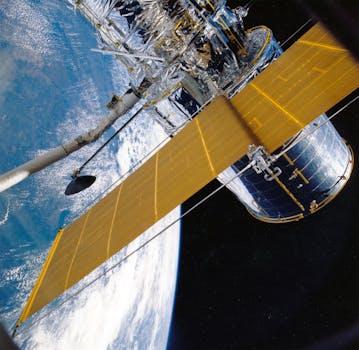
Beyond Earth: How Recent Advances in Satellite Tech are Shaping Global Communications
Recent advances in satellite technology are revolutionizing global communications, enabling faster and more reliable connections across the globe. Satellite technology has come a long way since its inception, with significant improvements in recent years. Beyond Earth: How Recent Advances in Satellite Tech are Shaping Global Communications is an exciting development that is transforming the way we communicate.
Satellite technology has been around for decades, but recent advances have made it more accessible and affordable. With the launch of new satellite constellations, such as OneWeb and Starlink, the possibilities for global communications have expanded exponentially. These constellations consist of hundreds of small satellites that orbit the Earth, providing internet connectivity to remote and underserved areas.
The Impact of Satellite Technology on Global Communications
The impact of satellite technology on global communications cannot be overstated. With the ability to provide internet connectivity to anyone, anywhere in the world, satellite technology is bridging the digital divide. This is especially significant for remote and underserved communities, where access to traditional telecommunications infrastructure is limited or non-existent. Satellite technology is also enabling emergency responders and disaster relief teams to communicate more effectively, saving lives and reducing the impact of natural disasters.
In addition to providing internet connectivity, satellite technology is also enabling the transmission of data, voice, and video communications. This is particularly useful for organizations that require secure and reliable communications, such as governments, financial institutions, and healthcare providers. Satellite technology is also being used to support the Internet of Things (IoT), enabling the connection of devices and sensors in remote and hard-to-reach areas.
Advances in Satellite Technology
Recent advances in satellite technology have made it possible to provide faster and more reliable communications. One of the key developments is the use of high-throughput satellites (HTS), which can transmit data at speeds of up to 100 Gbps. HTS satellites use multiple spot beams to transmit data, increasing the overall throughput and reducing the cost per bit.
Another significant development is the use of phased array antennas, which enable satellites to transmit and receive data simultaneously. This technology allows for more efficient use of bandwidth and increases the overall capacity of the satellite. Phased array antennas are also more compact and lighter than traditional antennas, making them ideal for use on smaller satellites.
The use of artificial intelligence (AI) and machine learning (ML) is also being explored in satellite technology. AI and ML can be used to optimize satellite operations, predict and prevent errors, and improve the overall performance of the satellite. This technology can also be used to analyze the vast amounts of data transmitted by satellites, providing valuable insights and supporting decision-making.
The Future of Satellite Technology
The future of satellite technology is exciting and full of possibilities. With the continued development of new technologies, such as quantum computing and 5G, the potential for satellite communications will only continue to grow. The use of satellite technology is also expected to expand into new areas, such as space exploration and the support of lunar and Mars missions.
In conclusion, recent advances in satellite technology are revolutionizing global communications, enabling faster and more reliable connections across the globe. With the continued development of new technologies and the expansion of satellite constellations, the possibilities for satellite communications will only continue to grow. As we look to the future, it is clear that satellite technology will play an increasingly important role in shaping the world of global communications.



